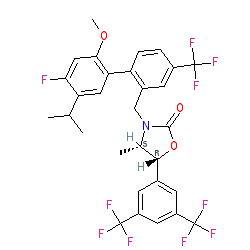GtoPdb is requesting financial support from commercial users. Please see our sustainability page for more information.
|
Synonyms: MK-0859
Compound class:
Synthetic organic
Comment: Anacetrapib is a small molecule that inhibits cholesterylester transfer protein (CETP; P11597) [3,10]. CETP was considered as a target for prevention of dyslipidemia and reducing cardiovascular mortality, with CETP inhibitors proposed as a direct route to raise HDL.
Clinical trial results for a number of CETP inhibitors have failed to show clinical benefit. Failed candidates include evacetrapib, anacetrapib, torcetrapib, and dalcetrapib [8]. Anacetrapib was discovered to have unfavourable pharmacokinetics, including a very extended terminal half-life (3-4 weeks) [1] and accumulation in adipose tissue (due to slow elimination from this tissue) [5,9]. Ligand Activity Visualisation ChartsThese are box plot that provide a unique visualisation, summarising all the activity data for a ligand taken from ChEMBL and GtoPdb across multiple targets and species. Click on a plot to see the median, interquartile range, low and high data points. A value of zero indicates that no data are available. A separate chart is created for each target, and where possible the algorithm tries to merge ChEMBL and GtoPdb targets by matching them on name and UniProt accession, for each available species. However, please note that inconsistency in naming of targets may lead to data for the same target being reported across multiple charts. ✖ |
|
|||||||||||||||||||||||||||||||||||
| References |
|
1. Dansky HM, Bloomfield D, Gibbons P, Liu S, Sisk CM, Tribble D, McKenney JM, Littlejohn 3rd TW, Mitchel Y. (2011)
Efficacy and safety after cessation of treatment with the cholesteryl ester transfer protein inhibitor anacetrapib (MK-0859) in patients with primary hypercholesterolemia or mixed hyperlipidemia. Am Heart J, 162 (4): 708-16. [PMID:21982664] |
|
2. Filippatos TD, Kei A, Elisaf MS. (2017)
Anacetrapib, a New CETP Inhibitor: The New Tool for the Management of Dyslipidemias?. Diseases, 5 (4). [PMID:28961179] |
|
3. Gutstein DE, Krishna R, Johns D, Surks HK, Dansky HM, Shah S, Mitchel YB, Arena J, Wagner JA. (2012)
Anacetrapib, a novel CETP inhibitor: pursuing a new approach to cardiovascular risk reduction. Clin Pharmacol Ther, 91 (1): 109-22. [PMID:22130116] |
|
4. Kastelein JJ, Besseling J, Shah S, Bergeron J, Langslet G, Hovingh GK, Al-Saady N, Koeijvoets M, Hunter J, Johnson-Levonas AO et al.. (2015)
Anacetrapib as lipid-modifying therapy in patients with heterozygous familial hypercholesterolaemia (REALIZE): a randomised, double-blind, placebo-controlled, phase 3 study. Lancet, 385 (9983): 2153-61. [PMID:25743173] |
|
5. Krishna R, Gheyas F, Liu Y, Hagen DR, Walker B, Chawla A, Cote J, Blaustein RO, Gutstein DE. (2017)
Chronic Administration of Anacetrapib Is Associated With Accumulation in Adipose and Slow Elimination. Clin Pharmacol Ther, 102 (5): 832-840. [PMID:28380664] |
|
6. Millar JS, Reyes-Soffer G, Jumes P, Dunbar RL, deGoma EM, Baer AL, Karmally W, Donovan DS, Rafeek H, Pollan L et al.. (2015)
Anacetrapib lowers LDL by increasing ApoB clearance in mildly hypercholesterolemic subjects. J Clin Invest, 125 (6): 2510-2522. [PMID:25961461] |
|
7. No authors listed. (2015)
Dyslipidaemia: Anacetrapib reduces LDL cholesterol in patients with heterozygous familial hypercholesterolaemia. Nat Rev Cardiol, 12 (5): 261. [PMID:25824513] |
|
8. Ready JM. (2021)
Toward a Best-in-Class Inhibitor of Cholesteryl Ester Transfer Protein (CETP). J Med Chem, 64 (18): 13212-13214. [PMID:34498872] |
|
9. Small DS, Ke AB, Hall SD, Mantlo N, Rotelli M, Friedrich S. (2015)
Assessment of the persistence of anacetrapib and evacetrapib concentrations using two pharmacokinetic modeling approaches. J Clin Pharmacol, 55 (7): 757-67. [PMID:25651523] |
|
10. Smith CJ, Ali A, Hammond ML, Li H, Lu Z, Napolitano J, Taylor GE, Thompson CF, Anderson MS, Chen Y et al.. (2011)
Biphenyl-substituted oxazolidinones as cholesteryl ester transfer protein inhibitors: modifications of the oxazolidinone ring leading to the discovery of anacetrapib. J Med Chem, 54 (13): 4880-95. [PMID:21682257] |






